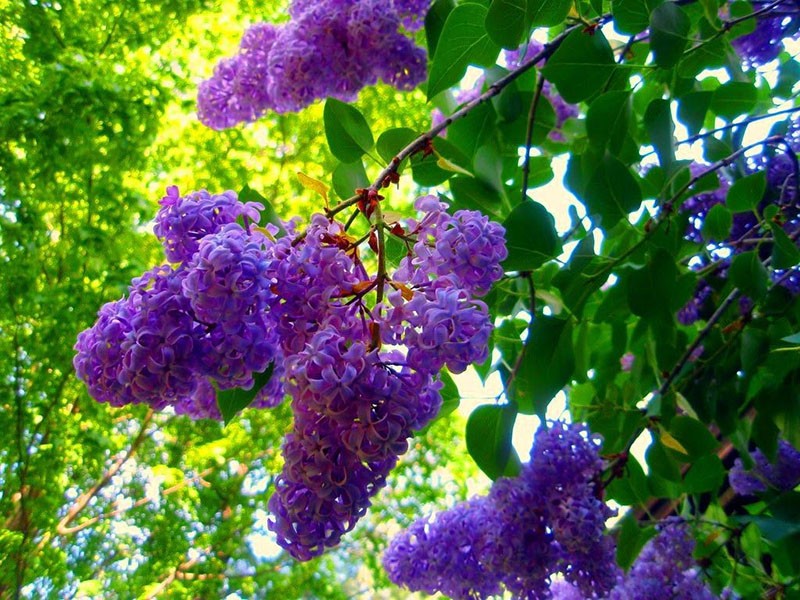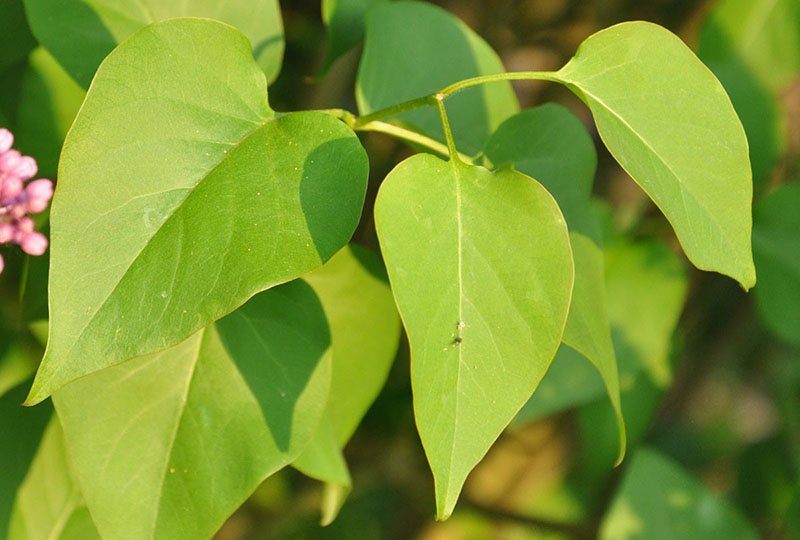The unique chemical composition and beneficial properties of lilacs for health
 Lush shrubs with fragrant bouquets annually announce the arrival of a sultry summer. However, the beneficial properties of lilacs evoke much more emotion in people. After all, a noble plant stores precious substances necessary for the human body. Traditional healers successfully use various parts of the lilac for the preparation of medicinal potions. Let's find out in detail what the culture looks like from the outside. What chemical compounds does it contain? What are its beneficial properties and contraindications? And also we will get acquainted with popular recipes of medicinal drugs from the “treasury” of traditional medicine.
Lush shrubs with fragrant bouquets annually announce the arrival of a sultry summer. However, the beneficial properties of lilacs evoke much more emotion in people. After all, a noble plant stores precious substances necessary for the human body. Traditional healers successfully use various parts of the lilac for the preparation of medicinal potions. Let's find out in detail what the culture looks like from the outside. What chemical compounds does it contain? What are its beneficial properties and contraindications? And also we will get acquainted with popular recipes of medicinal drugs from the “treasury” of traditional medicine.
"Fragrant lilac bloomed under my window"

 The leaf plates of the plant are ovoid, oval or lanceolate. Their surface is glossy. The tips are pointed. The color is deep green. Funnel-shaped buds are collected in paniculate inflorescences. They have a pleasant fragrant aroma. Thanks to the work of breeders, many varieties have appeared.
The leaf plates of the plant are ovoid, oval or lanceolate. Their surface is glossy. The tips are pointed. The color is deep green. Funnel-shaped buds are collected in paniculate inflorescences. They have a pleasant fragrant aroma. Thanks to the work of breeders, many varieties have appeared.
The main difference is the color of the buds, which happens:
- purple;
- pink;
- purple;
- white;
- blue;
- lilac.
Despite its charms, lilacs are a poisonous plant that can harm a person.
For example, the fragrant scent of the buds causes headaches. And preparations obtained from parts of the bush are taken no longer than 21 days. In addition, they adhere to a strict dosage. Let's consider in detail what chemicals the famous garden shrub contains.
A unique formula for the benefit of people
 The vegetation of our planet is considered a storehouse of valuable components necessary for the successful life of the organism. Traditional healers use these gifts to treat various ailments. And thanks to the research of scientists, the beneficial properties of lilac and many other plants were discovered. Today it is known that the fragrant buds of the shrub contain an abundance of essential oils. In addition, they contain the bitter glucoside syringin and farnesol, components necessary for the body.
The vegetation of our planet is considered a storehouse of valuable components necessary for the successful life of the organism. Traditional healers use these gifts to treat various ailments. And thanks to the research of scientists, the beneficial properties of lilac and many other plants were discovered. Today it is known that the fragrant buds of the shrub contain an abundance of essential oils. In addition, they contain the bitter glucoside syringin and farnesol, components necessary for the body.
Lilac leaf plates, buds and bark contain:
- alkaloids;
- various types of resins;
- flavonoids;
- tannins;
- ascorbic acid;
- phytoncides;
- tannins.
 To preserve the valuable components and essential oils of lilac, raw materials are harvested in sunny weather. The inflorescences are cut at the very beginning of budding. They are carefully separated from the branches and dried, first in an open area, and then in the shade. The leaf plates are torn off before early July, and the buds in early spring. The finished raw materials are stored in a dark, dry room for no longer than 2 years.
To preserve the valuable components and essential oils of lilac, raw materials are harvested in sunny weather. The inflorescences are cut at the very beginning of budding. They are carefully separated from the branches and dried, first in an open area, and then in the shade. The leaf plates are torn off before early July, and the buds in early spring. The finished raw materials are stored in a dark, dry room for no longer than 2 years.
Most often in traditional medicine, flowers of the plant are used, dried in a traditional way.
We use the beneficial properties of lilacs to combat ailments
 For the preparation of healing potions, traditional healers use almost all parts of the bush.As a result, they receive aromatic tinctures, ointments, teas and decoctions. The culture was appreciated by perfumers and beauticians. Essential oils are added to cream, lotion, and perfume. Even culinary specialists sugar-coated bush buds to decorate gourmet dishes. What are the medicinal properties and contraindications of lilac leaves, buds and inflorescences for the body? Find out what the experts are saying.
For the preparation of healing potions, traditional healers use almost all parts of the bush.As a result, they receive aromatic tinctures, ointments, teas and decoctions. The culture was appreciated by perfumers and beauticians. Essential oils are added to cream, lotion, and perfume. Even culinary specialists sugar-coated bush buds to decorate gourmet dishes. What are the medicinal properties and contraindications of lilac leaves, buds and inflorescences for the body? Find out what the experts are saying.
Healing leaf plates
 A rich green mass adorns the shrub throughout the season. It contains an abundance of chemical compounds that have antibacterial properties. Therefore, traditional healers actively use it for medicinal purposes. A tincture is prepared from the foliage for the treatment of purulent wounds and lingering inflammation of the skin. 1 liter of boiling water is poured into a thermos. Add a tablespoon of chopped lilac leaves. Insist 3 hours. Strain through cheesecloth folded in 2 layers. Store in the refrigerator for no more than 2 days.
A rich green mass adorns the shrub throughout the season. It contains an abundance of chemical compounds that have antibacterial properties. Therefore, traditional healers actively use it for medicinal purposes. A tincture is prepared from the foliage for the treatment of purulent wounds and lingering inflammation of the skin. 1 liter of boiling water is poured into a thermos. Add a tablespoon of chopped lilac leaves. Insist 3 hours. Strain through cheesecloth folded in 2 layers. Store in the refrigerator for no more than 2 days.
Fresh leaf plates can be applied to wounds after rinsing them with hot water. In this case, they act as an antiseptic.
 In addition, an ointment is made from fresh lilac foliage to treat joints. First they are rinsed under the tap. Then it is crushed and mixed with pork fat.
In addition, an ointment is made from fresh lilac foliage to treat joints. First they are rinsed under the tap. Then it is crushed and mixed with pork fat.
Alcohol tincture is prepared from such componentsin:
- lilac leaf plates (tablespoon);
- winter juice radish (150 ml);
- honey (100 g);
- vodka or alcohol (100 ml).
The ingredients are put in a glass container and infused for 24 hours. The resulting mixture is rubbed with inflamed joints 1 time per day. A warming bandage is applied on top.
Early Spring Gift
 People have known about the benefits of lilac buds for a long time. Unfolded foliage contains a huge amount of ascorbic acid. Therefore, the raw materials are used to treat respiratory ailments.
People have known about the benefits of lilac buds for a long time. Unfolded foliage contains a huge amount of ascorbic acid. Therefore, the raw materials are used to treat respiratory ailments.
The drug is prepared according to the following scheme:
- crushed lilac buds (2 tablespoons) are mixed with buds (tablespoon);
- the mixture is poured with boiling water (250 ml);
- insist for an hour;
- filter.
The drink is taken half an hour before meals in several doses. The course of treatment is prescribed by the doctor, taking into account the degree of the disease. Thanks to the active substances, relief comes already on the third day after the start of taking the drug.
 In addition, in folk medicine, lilac buds are actively used to treat type II diabetes. The dried raw materials are poured with a glass of boiling water. Stir well and simmer over low heat for 15 minutes. When the mass has cooled down a little, filter it through a tea strainer. Drink before eating a tablespoon.
In addition, in folk medicine, lilac buds are actively used to treat type II diabetes. The dried raw materials are poured with a glass of boiling water. Stir well and simmer over low heat for 15 minutes. When the mass has cooled down a little, filter it through a tea strainer. Drink before eating a tablespoon.
Fragrant bouquet for health
 Enjoying the beauty of the flowering shrub at the end of spring, many remember the healing properties of lilac flowers for the body. They diligently procure raw materials to prepare natural "medicine" in "hard times."
Enjoying the beauty of the flowering shrub at the end of spring, many remember the healing properties of lilac flowers for the body. They diligently procure raw materials to prepare natural "medicine" in "hard times."
Alcoholic tincture from the buds is used for such ailments:
- diarrhea;
- rheumatism;
- arthritis;
- ARI;
- pulmonary tuberculosis.
It is prepared quite simply. Vodka or alcohol diluted with water to 50 ° is poured into a glass jar. Then put in liquid 100 g of dry buds. Stir, cover with a lid. Insist in the dark for 21 days, periodically shaking the mixture. The dose is determined by a specialist, taking into account the age and degree of the patient's illness.
 No less popular in folk medicine white lilac, from which medicinal drinks are also obtained. It includes a number of chemical compounds that are important for the life of the body. Dry raw materials are poured with boiling water (200 ml is enough for a tablespoon). Insist under the lid, wrapped in a terry towel, for about 30 minutes. It is taken to strengthen immunity in a tablespoon 3-4 times a day.
No less popular in folk medicine white lilac, from which medicinal drinks are also obtained. It includes a number of chemical compounds that are important for the life of the body. Dry raw materials are poured with boiling water (200 ml is enough for a tablespoon). Insist under the lid, wrapped in a terry towel, for about 30 minutes. It is taken to strengthen immunity in a tablespoon 3-4 times a day.
Before starting herbal treatment, you need to consult a doctor. Otherwise, the medicinal drug can adversely affect health.
Panacea for all ills
 To keep fit, many people exercise and eat healthy foods.But, unfortunately, no one is immune from disease. However, if the house contains valuable raw materials from scented buds, the problem can be easily solved. After all, scientists have confirmed a number of medicinal properties of lilac tincture, which manifest themselves in various directions.
To keep fit, many people exercise and eat healthy foods.But, unfortunately, no one is immune from disease. However, if the house contains valuable raw materials from scented buds, the problem can be easily solved. After all, scientists have confirmed a number of medicinal properties of lilac tincture, which manifest themselves in various directions.
Taking tinctures from a plant has the following effects:
- removes fluid from the body;
- regulates blood sugar levels;
- relieves inflammation;
- relieves pain syndrome;
- heals wounds.
 The drink is used for pain in the bladder. It is made according to a simple scheme. Dry inflorescences (10 g) are poured with boiling water (200 ml). Insist 1 hour. Filter through 2 layers of gauze. Drink 4 times a day for a tablespoon. A similar tincture is also prepared for stomach ulcers. However, a teaspoon of flowers is added to 200 ml of water. Despite the popularity of recipes, the benefits and harms of lilacs for the body remain an important aspect in the treatment of diseases.
The drink is used for pain in the bladder. It is made according to a simple scheme. Dry inflorescences (10 g) are poured with boiling water (200 ml). Insist 1 hour. Filter through 2 layers of gauze. Drink 4 times a day for a tablespoon. A similar tincture is also prepared for stomach ulcers. However, a teaspoon of flowers is added to 200 ml of water. Despite the popularity of recipes, the benefits and harms of lilacs for the body remain an important aspect in the treatment of diseases.
Since the plant contains toxic substances, it is contraindicated.:
- pregnant and lactating women;
- small children;

- allergy sufferers.
Caution should be exercised when using lilac tinctures for those who have renal failure and serious liver problems. It is undesirable to take drugs for women who have an irregular menstrual cycle.
In case of overdose, dizziness, nausea, rash, shortness of breath occur. An ambulance should be called at the first symptoms.
We examined in detail the beneficial properties of lilacs for the human body. They appear in different directions. Thanks to this, traditional healers have created a number of recipes according to which medicinal medicines are prepared. The dose is prescribed by the attending physician, taking into account the contraindications. Let us carefully monitor our health.